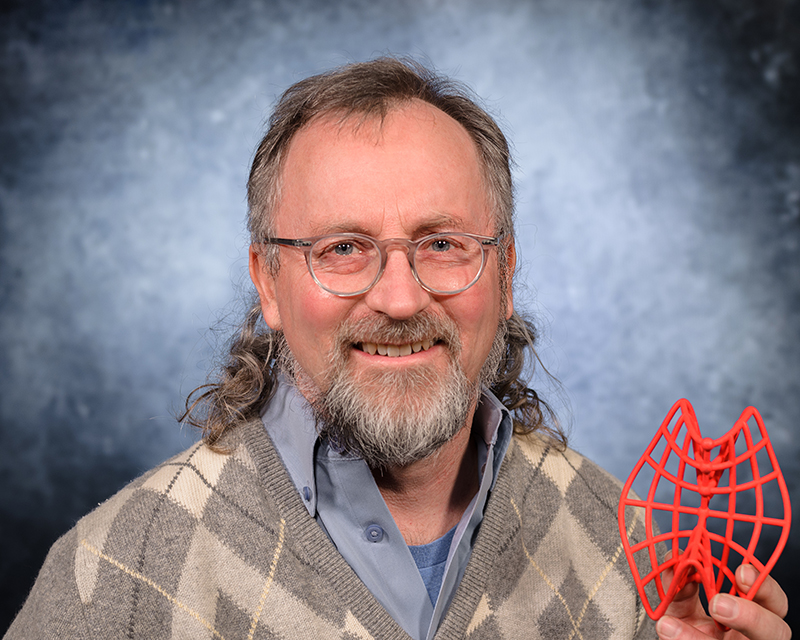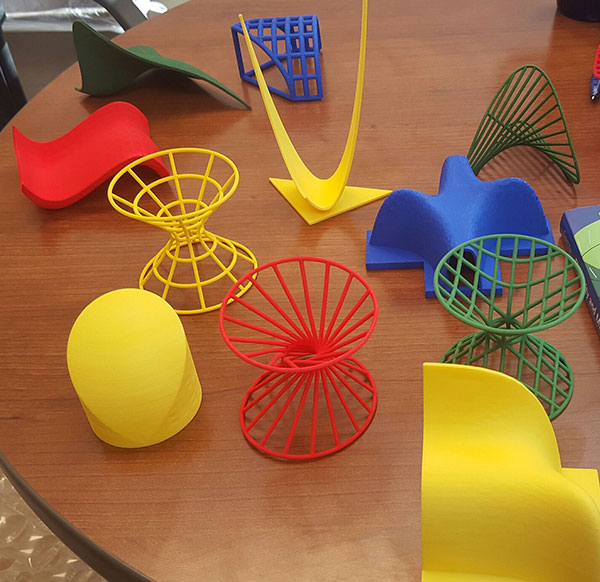
“Handing a group of students a 3-D model allows them to grasp its structure for themselves, with each group learning at their own pace," said Dr. John Zweck, mathematics professor at UT Dallas.
A University of Texas at Dallas math professor has embraced 3-D printing to help calculus students develop the ability to visualize geometric objects.
Dr. John Zweck, a professor in the Department of Mathematical Sciences, has created a collection of 3-D printed models that his students use in small-group problem-solving assignments.
In general, calculus is the mathematical study of change, dealing with functions and equations that describe and make predictions about processes in science and engineering. In the UT Dallas course Calculus III, students take on multivariable functions.
“Multivariable calculus combines geometric, algebraic and logical modes of thinking all at once,” Zweck said. “It can require a new way of looking at things, a new problem-solving technique.”
An important element of tackling multivariable calculus is developing an understanding of three-dimensional objects that may only be presented as formulas or two-dimensional drawings of various types of surfaces and shapes.
“I call it geometric imagination — helping students learn to form and manipulate geometric objects in their minds,” Zweck said. “Creative mathematics at any level relies on forming pictures in your head, then explaining them. But no professor’s verbal descriptions guarantee that a group of students all conjure the same image at the same time.”
For Zweck, this new solution to an old problem came about almost by accident — and not before considering a variety of methods.
“For years, I’ve been at the front of a room, standing on a desk, trying to physically represent a saddle surface with my arms and legs,” Zweck said. “Then drawing on the whiteboard, or using transparencies. Both representations are far from ideal.”
Warming Up to 3-D Technology
Zweck initially considered virtual reality as a potential tool, but found it limited in several ways.
“It’s too high-tech, too much technology,” Zweck said. “It also removes the simultaneous group experience element. Having students communicate with each other is a huge factor in how they learn.”
“The students make clear that they are learning in these group exercises. Seeing that they get so much out of those sessions, and seeing that they realize that, tells me that we’re doing the right thing. ”
— Dr. John Zweck,
mathematics professor
in the School of Natural Sciences and Mathematics
Zweck had been introduced in the abstract to 3-D printing in 2003 by a colleague, but he “had no idea why I’d care about it” until 2014.
“I’d been thinking about how to solve this visualization problem, and I read the title of a blog post about 3-D printing your own flip-flops,” Zweck said. “I realized, if you can print your own flip-flops, you can print anything.”
That year, the National Science Foundation announced a call for researchers to improve the success of first- and second-year STEM students in mathematics courses. Dr. Mary Urquhart, the head of the Department of Science and Mathematics Education in the School of Natural Sciences and Mathematics, and Dr. Sue Minkoff, a professor in the Department of Mathematical Sciences who also teaches Multivariable Calculus, already shared an NSF grant with Zweck that supported the UTeach Dallas Robert Noyce Scholarship Program.
“We partnered with Dr. Urquhart to secure an $80,000 supplement to the Noyce award,” Zweck said. “That paid for the models to be produced, and for the undergraduate teaching assistants that help facilitate our small-group problem-solving sessions.”
About four times a semester in these active learning sessions, groups of three to four students tackle problems using one of the 3-D printed shapes.
“Each student group has a model, and we do a roughly 20-minute exercise that delves deeply into understanding a surface such as a saddle surface,” Zweck said. “Handing a group of students a 3-D model allows them to grasp its structure for themselves, with each group learning at their own pace. I showed the models to students from past semesters, and they said they wished they had these when they took the course.”
Literally Grasping a Concept
The 3-D models help many students clear a significant, early hurdle to grasping the math behind the shape.

Using the 3-D models, the active learning sessions help students mature in the subject by forcing them to explain things to each other, Zweck said.
“I found the models useful when talking about limits and absolute maximums and minimums,” said Archit Singh, a junior studying molecular biology. “With limits, having 3-D meshes greatly helps visualize the paths that must all lead to the same point. With max and min, a 3-D model allows an easy look at the corners and edges where they may exist.”
Using the models, the active learning sessions help students mature in the subject by forcing them to explain things to each other, Zweck said.
“They start to learn to think in the subject, to solve problems that require creativity, merging concepts together,” he said. “Students can often write it on the board, but can’t explain it — no one’s ever asked them to. I’m asking them to explain to each other what they’re doing. If you can explain math to somebody, you can explain anything technical.”
These skills apply to a wide subject area, and to many eventual fields of study and work.
“When these students go out and get jobs, they’ll have to be able to explain the value of what they’re doing, to sell their project within their company,” Zweck said. “UT Dallas is one of the few institutions that’s using 3-D printed models in this manner, especially at the sophomore level.”
The active learning sessions and 3-D models have received largely positive feedback.
“The students make clear that they are learning in these group exercises,” Zweck said. “Seeing that they get so much out of those sessions, and seeing that they realize that, tells me that we’re doing the right thing.”